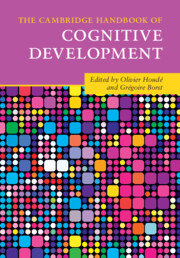Book contents
- The Cambridge Handbook of Cognitive Development
- The Cambridge Handbook of Cognitive Development
- Copyright page
- Contents
- Figures
- Tables
- Contributors
- Introduction
- Part I Neurobiological Constraints and Laws of Cognitive Development
- Part II Fundamentals of Cognitive Development from Infancy to Adolescence and Young Adulthood
- Introduction
- Subpart II.1 Infancy: The Roots of Human Thinking
- Subpart II.2 Childhood and Adolescence: The Development of Human Thinking
- 15 Development of Qualitative Thinking
- 16 Development of Numerical Knowledge
- 17 Numerical Cognition and Executive Functions
- 18 Developing Theory of Mind and Counterfactual Reasoning in Children
- 19 Development of Executive Function Skills in Childhood
- 20 Developing Cognitive Control and Flexible Adaptation during Childhood
- 21 Reasoning Bias and Dual Process Theory
- 22 Social Cognitive Development
- 23 Behavioral and Neural Development of Cognitive Control and Risky Decision-Making across Adolescence
- 24 The Triadic Neural Systems Model through a Machine-Learning Mill
- Part III Education and School-Learning Domains
- Index
- Plate Section (PDF Only)
- References
16 - Development of Numerical Knowledge
from Subpart II.2 - Childhood and Adolescence: The Development of Human Thinking
Published online by Cambridge University Press: 24 February 2022
- The Cambridge Handbook of Cognitive Development
- The Cambridge Handbook of Cognitive Development
- Copyright page
- Contents
- Figures
- Tables
- Contributors
- Introduction
- Part I Neurobiological Constraints and Laws of Cognitive Development
- Part II Fundamentals of Cognitive Development from Infancy to Adolescence and Young Adulthood
- Introduction
- Subpart II.1 Infancy: The Roots of Human Thinking
- Subpart II.2 Childhood and Adolescence: The Development of Human Thinking
- 15 Development of Qualitative Thinking
- 16 Development of Numerical Knowledge
- 17 Numerical Cognition and Executive Functions
- 18 Developing Theory of Mind and Counterfactual Reasoning in Children
- 19 Development of Executive Function Skills in Childhood
- 20 Developing Cognitive Control and Flexible Adaptation during Childhood
- 21 Reasoning Bias and Dual Process Theory
- 22 Social Cognitive Development
- 23 Behavioral and Neural Development of Cognitive Control and Risky Decision-Making across Adolescence
- 24 The Triadic Neural Systems Model through a Machine-Learning Mill
- Part III Education and School-Learning Domains
- Index
- Plate Section (PDF Only)
- References
Summary
Numerical knowledge is of great and growing importance. While children are attending school, numerical knowledge is essential for learning more advanced mathematics and science, and eventually for learning computer science, psychology, sociology, economics, and a host of other subjects. After children leave school, numerical knowledge is essential not just in STEM areas but also in a wide range of other occupations. Illustratively, a survey of more than 2,000 employed people in the United States, chosen through random digit dials, indicated that 94 percent reported using math in their work, including majorities in occupations classified as upper white collar, lower white collar, upper blue collar, and lower blue collar (Handel, 2016). Moreover, numerical proficiency is related to occupational success: numerical knowledge at age seven years predicts SES at age forty-two years, even after statistically controlling for IQ, years of education, reading skill, working memory, race, and family SES (Ritchie & Bates, 2013).
- Type
- Chapter
- Information
- The Cambridge Handbook of Cognitive Development , pp. 361 - 382Publisher: Cambridge University PressPrint publication year: 2022



